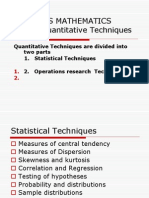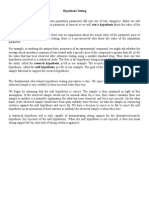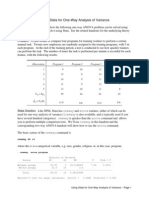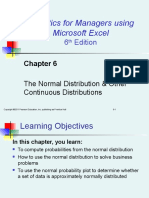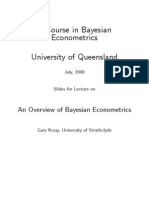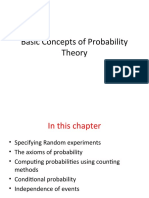Groebner Business Statistics 7 Ch06
Groebner Business Statistics 7 Ch06
Uploaded by
Zeeshan RiazCopyright:
Available Formats
Groebner Business Statistics 7 Ch06
Groebner Business Statistics 7 Ch06
Uploaded by
Zeeshan RiazOriginal Title
Copyright
Available Formats
Share this document
Did you find this document useful?
Is this content inappropriate?
Copyright:
Available Formats
Groebner Business Statistics 7 Ch06
Groebner Business Statistics 7 Ch06
Uploaded by
Zeeshan RiazCopyright:
Available Formats
Business Statistics: A Decision-Making Approach, 7e 2008 Prentice-Hall, Inc.
Chap 6-1
Business Statistics:
A Decision-Making Approach
7
th
Edition
Chapter 6
Introduction to Continuous
Probability Distributions
Business Statistics: A Decision-Making Approach, 7e 2008 Prentice-Hall, Inc. Chap 6-2
Chapter Goals
After completing this chapter, you should be
able to:
Convert values from any normal distribution to a
standardized z-score
Find probabilities using a normal distribution table
Apply the normal distribution to business problems
Recognize when to apply the uniform and
exponential distributions
Business Statistics: A Decision-Making Approach, 7e 2008 Prentice-Hall, Inc. Chap 6-3
Probability Distributions
Continuous
Probability
Distributions
Binomial
Hypergeometric
Poisson
Probability
Distributions
Discrete
Probability
Distributions
Normal
Uniform
Exponential
Ch. 5 Ch. 6
Business Statistics: A Decision-Making Approach, 7e 2008 Prentice-Hall, Inc. Chap 6-4
Continuous Probability
Distributions
A continuous random variable is a variable that
can assume any value on a continuum (can
assume an uncountable number of values)
thickness of an item
time required to complete a task
temperature of a solution
height, in inches
These can potentially take on any value,
depending only on the ability to measure
accurately.
Business Statistics: A Decision-Making Approach, 7e 2008 Prentice-Hall, Inc. Chap 6-5
The Normal Distribution
Continuous
Probability
Distributions
Probability
Distributions
Normal
Uniform
Exponential
Business Statistics: A Decision-Making Approach, 7e 2008 Prentice-Hall, Inc. Chap 6-6
The Normal Distribution
Bell Shaped
Symmetrical
Mean, Median and Mode
are Equal
Location is determined by the
mean,
Spread is determined by the
standard deviation,
The random variable has an
infinite theoretical range:
+ to
Mean
= Median
= Mode
x
f(x)
Business Statistics: A Decision-Making Approach, 7e 2008 Prentice-Hall, Inc. Chap 6-7
By varying the parameters and , we obtain
different normal distributions
Many Normal Distributions
Business Statistics: A Decision-Making Approach, 7e 2008 Prentice-Hall, Inc. Chap 6-8
The Normal Distribution Shape
x
f(x)
Changing shifts the
distribution left or right.
Changing increases
or decreases the
spread.
Business Statistics: A Decision-Making Approach, 7e 2008 Prentice-Hall, Inc. Chap 6-9
Finding Normal Probabilities
a b
x
f(x)
P a x b (
)
s s
Probability is measured by the area
under the curve
Business Statistics: A Decision-Making Approach, 7e 2008 Prentice-Hall, Inc. Chap 6-10
f(x)
x
Probability as
Area Under the Curve
0.5 0.5
The total area under the curve is 1.0, and the curve is
symmetric, so half is above the mean, half is below
1.0 ) x P( = < <
0.5 ) x P( = < <
0.5 ) x P( = < <
Business Statistics: A Decision-Making Approach, 7e 2008 Prentice-Hall, Inc. Chap 6-11
Empirical Rules
1 encloses about
68% of xs
f(x)
x
+1 1
What can we say about the distribution of values
around the mean? There are some general rules:
68.26%
Business Statistics: A Decision-Making Approach, 7e 2008 Prentice-Hall, Inc. Chap 6-12
The Empirical Rule
2 covers about 95% of xs
3 covers about 99.7% of xs
x
2 2
x
3 3
95.44% 99.72%
(continued)
Business Statistics: A Decision-Making Approach, 7e 2008 Prentice-Hall, Inc. Chap 6-13
Importance of the Rule
If a value is about 2 or more standard
deviations away from the mean in a normal
distribution, then it is far from the mean
The chance that a value that far or farther
away from the mean is highly unlikely, given
that particular mean and standard deviation
Business Statistics: A Decision-Making Approach, 7e 2008 Prentice-Hall, Inc. Chap 6-14
The Standard Normal Distribution
Also known as the z distribution
Mean is defined to be 0
Standard Deviation is 1
z
f(z)
0
1
Values above the mean have positive z-values,
values below the mean have negative z-values
Business Statistics: A Decision-Making Approach, 7e 2008 Prentice-Hall, Inc. Chap 6-15
The Standard Normal
Any normal distribution (with any mean and
standard deviation combination) can be
transformed into the standard normal
distribution (z)
Need to transform x units into z units
Business Statistics: A Decision-Making Approach, 7e 2008 Prentice-Hall, Inc. Chap 6-16
Translation to the Standard
Normal Distribution
Translate from x to the standard normal (the
z distribution) by subtracting the mean of x
and dividing by its standard deviation:
x
z
=
Business Statistics: A Decision-Making Approach, 7e 2008 Prentice-Hall, Inc. Chap 6-17
Example
If x is distributed normally with mean of 100
and standard deviation of 50, the z value for
x = 250 is
This says that x = 250 is three standard
deviations (3 increments of 50 units) above
the mean of 100.
3.0
50
100 250
x
z =
=
Business Statistics: A Decision-Making Approach, 7e 2008 Prentice-Hall, Inc. Chap 6-18
Comparing x and z units
z
100
3.0 0
250 x
Note that the distribution is the same, only the
scale has changed. We can express the problem in
original units (x) or in standardized units (z)
= 100
= 50
Business Statistics: A Decision-Making Approach, 7e 2008 Prentice-Hall, Inc. Chap 6-19
The Standard Normal Table
The Standard Normal table in the textbook
(Appendix D)
gives the probability from the mean (zero)
up to a desired value for z
z
0 2.00
.4772
Example:
P(0 < z < 2.00) = .4772
Business Statistics: A Decision-Making Approach, 7e 2008 Prentice-Hall, Inc. Chap 6-20
The Standard Normal Table
The value within the
table gives the
probability from z = 0
up to the desired z
value
z 0.00 0.01 0.02
0.1
0.2
.4772
2.0
P(0 < z < 2.00) = .4772
The row shows
the value of z
to the first
decimal point
The column gives the value of
z to the second decimal point
2.0
.
.
.
(continued)
Business Statistics: A Decision-Making Approach, 7e 2008 Prentice-Hall, Inc. Chap 6-21
General Procedure for
Finding Probabilities
Draw the normal curve for the problem in
terms of x
Translate x-values to z-values
Use the Standard Normal Table
To find P(a < x < b) when x is distributed
normally:
Business Statistics: A Decision-Making Approach, 7e 2008 Prentice-Hall, Inc. Chap 6-22
Z Table example
Suppose x is normal with mean 8.0 and
standard deviation 5.0. Find P(8 < x < 8.6)
P(8 < x < 8.6)
= P(0 < z < 0.12)
Z 0.12 0
x 8.6 8
0
5
8 8
x
z =
=
0.12
5
8 8.6
x
z =
=
Calculate z-values:
Business Statistics: A Decision-Making Approach, 7e 2008 Prentice-Hall, Inc. Chap 6-23
Z Table example
Suppose x is normal with mean 8.0 and
standard deviation 5.0. Find P(8 < x < 8.6)
P(0 < z < 0.12)
z
0.12 0
x
8.6 8
P(8 < x < 8.6)
= 8
o = 5
= 0
o = 1
(continued)
Business Statistics: A Decision-Making Approach, 7e 2008 Prentice-Hall, Inc. Chap 6-24
Z
0.12
z .00 .01
0.0 .0000 .0040 .0080
.0398
.0438
0.2 .0793 .0832 .0871
0.3 .1179 .1217 .1255
Solution: Finding P(0 < z < 0.12)
.0478
.02
0.1
.0478
Standard Normal Probability
Table (Portion)
0.00
= P(0 < z < 0.12)
P(8 < x < 8.6)
Business Statistics: A Decision-Making Approach, 7e 2008 Prentice-Hall, Inc. Chap 6-25
Finding Normal Probabilities
Suppose x is normal with mean 8.0
and standard deviation 5.0.
Now Find P(x < 8.6)
Z
8.6
8.0
Business Statistics: A Decision-Making Approach, 7e 2008 Prentice-Hall, Inc. Chap 6-26
Finding Normal Probabilities
Suppose x is normal with mean 8.0
and standard deviation 5.0.
Now Find P(x < 8.6)
(continued)
Z
0.12
.0478
0.00
.5000
P(x < 8.6)
= P(z < 0.12)
= P(z < 0) + P(0 < z < 0.12)
= .5 + .0478 = .5478
Business Statistics: A Decision-Making Approach, 7e 2008 Prentice-Hall, Inc. Chap 6-27
Upper Tail Probabilities
Suppose x is normal with mean 8.0
and standard deviation 5.0.
Now Find P(x > 8.6)
Z
8.6
8.0
Business Statistics: A Decision-Making Approach, 7e 2008 Prentice-Hall, Inc. Chap 6-28
Now Find P(x > 8.6)
(continued)
Z
0.12
0
Z
0.12
.0478
0
.5000
.50 - .0478
= .4522
P(x > 8.6) = P(z > 0.12) = P(z > 0) - P(0 < z < 0.12)
= .5 - .0478 = .4522
Upper Tail Probabilities
Business Statistics: A Decision-Making Approach, 7e 2008 Prentice-Hall, Inc. Chap 6-29
Lower Tail Probabilities
Suppose x is normal with mean 8.0
and standard deviation 5.0.
Now Find P(7.4 < x < 8)
Z
7.4
8.0
Business Statistics: A Decision-Making Approach, 7e 2008 Prentice-Hall, Inc. Chap 6-30
Lower Tail Probabilities
Now Find P(7.4 < x < 8)
Z
7.4
8.0
The Normal distribution is
symmetric, so we use the
same table even if z-values
are negative:
P(7.4 < x < 8)
= P(-0.12 < z < 0)
= .0478
(continued)
.0478
Business Statistics: A Decision-Making Approach, 7e 2008 Prentice-Hall, Inc. Chap 6-31
Normal Probabilities in PHStat
We can use Excel and PHStat to quickly
generate probabilities for any normal
distribution
We will find P(8 < x < 8.6) when x is
normally distributed with mean 8 and
standard deviation 5
Business Statistics: A Decision-Making Approach, 7e 2008 Prentice-Hall, Inc. Chap 6-32
PHStat Dialogue Box
Select desired options
and enter values
Business Statistics: A Decision-Making Approach, 7e 2008 Prentice-Hall, Inc. Chap 6-33
PHStat Output
Business Statistics: A Decision-Making Approach, 7e 2008 Prentice-Hall, Inc. Chap 6-34
The Uniform Distribution
Continuous
Probability
Distributions
Probability
Distributions
Normal
Uniform
Exponential
Business Statistics: A Decision-Making Approach, 7e 2008 Prentice-Hall, Inc. Chap 6-35
The Uniform Distribution
The uniform distribution is a
probability distribution that has
equal probabilities for all possible
outcomes of the random variable
Business Statistics: A Decision-Making Approach, 7e 2008 Prentice-Hall, Inc. Chap 6-36
The Continuous Uniform Distribution:
otherwise 0
b x a if
a b
1
s s
where
f(x) = value of the density function at any x value
a = lower limit of the interval
b = upper limit of the interval
The Uniform Distribution
(continued)
f(x) =
Business Statistics: A Decision-Making Approach, 7e 2008 Prentice-Hall, Inc. Chap 6-37
The mean (expected value) is:
2
b a
E(x)
+
= =
where
a = lower limit of the interval from a to b
b = upper limit of the interval from a to b
The Mean and Standard Deviation
for the Uniform Distribution
The standard deviation is
12
a) (b
=
Business Statistics: A Decision-Making Approach, 7e 2008 Prentice-Hall, Inc. Chap 6-38
Uniform Distribution
Example: Uniform Probability Distribution
Over the range 2 x 6:
2 6
.25
f(x) = = .25 for 2 x 6
6 - 2
1
x
f(x)
Business Statistics: A Decision-Making Approach, 7e 2008 Prentice-Hall, Inc. Chap 6-39
Uniform Distribution
Example: Uniform Probability Distribution
Over the range 2 x 6:
4
2
6 2
E(x) =
+
= =
1.1547
12
2) (6
12
a) (b
2 2
=
=
Business Statistics: A Decision-Making Approach, 7e 2008 Prentice-Hall, Inc. Chap 6-40
The Exponential Distribution
Continuous
Probability
Distributions
Probability
Distributions
Normal
Uniform
Exponential
Business Statistics: A Decision-Making Approach, 7e 2008 Prentice-Hall, Inc. Chap 6-41
The Exponential Distribution
Used to measure the time that elapses
between two occurrences of an event (the
time between arrivals)
Examples:
Time between trucks arriving at an unloading
dock
Time between transactions at an ATM Machine
Time between phone calls to the main operator
Business Statistics: A Decision-Making Approach, 7e 2008 Prentice-Hall, Inc. Chap 6-42
The Exponential Distribution
a
e 1 a) x P(0
= s s
The probability that an arrival time is equal to or
less than some specified time a is
where 1/ is the mean time between events
Note that if the number of occurrences per time period is Poisson
with mean , then the time between occurrences is exponential
with mean time 1/
Business Statistics: A Decision-Making Approach, 7e 2008 Prentice-Hall, Inc. Chap 6-43
Exponential Distribution
Shape of the exponential distribution
(continued)
f(x)
x
= 1.0
(mean = 1.0)
= 0.5
(mean = 2.0)
= 3.0
(mean = .333)
Business Statistics: A Decision-Making Approach, 7e 2008 Prentice-Hall, Inc. Chap 6-44
Example
Example: Customers arrive at the claims counter at
the rate of 15 per hour (Poisson distributed). What
is the probability that the arrival time between
consecutive customers is less than five minutes?
Time between arrivals is exponentially distributed
with mean time between arrivals of 4 minutes (15
per 60 minutes, on average)
1/ = 4.0, so = .25
P(x < 5) = 1 - e
-a
= 1 e
-(.25)(5)
= .7135
Business Statistics: A Decision-Making Approach, 7e 2008 Prentice-Hall, Inc. Chap 6-45
Using PHStat
Business Statistics: A Decision-Making Approach, 7e 2008 Prentice-Hall, Inc. Chap 6-46
Chapter Summary
Reviewed key continuous distributions
normal
uniform
exponential
Found probabilities using formulas and tables
Recognized when to apply different distributions
Applied distributions to decision problems
You might also like
- ST2187 Business Analytics Applied Modelling and PredictionDocument2 pagesST2187 Business Analytics Applied Modelling and PredictionMihirinie AbhayawardhanaNo ratings yet
- Chapter 6Document50 pagesChapter 6Khairul Nidzam0% (1)
- AP Statistics Project - Gummy BearsDocument5 pagesAP Statistics Project - Gummy BearsFVCproductionsNo ratings yet
- Groebner Business Statistics 7 Ch07Document34 pagesGroebner Business Statistics 7 Ch07Zeeshan RiazNo ratings yet
- Groebner Business Statistics 7 Ch05Document39 pagesGroebner Business Statistics 7 Ch05Zeeshan RiazNo ratings yet
- Groebner ch05Document69 pagesGroebner ch05Pramudya MuhamadNo ratings yet
- Groebner Business Statistics 7 Ch15Document70 pagesGroebner Business Statistics 7 Ch15Zeeshan RiazNo ratings yet
- Solutions Manual to Accompany Introduction to Quantitative Methods in Business: with Applications Using Microsoft Office ExcelFrom EverandSolutions Manual to Accompany Introduction to Quantitative Methods in Business: with Applications Using Microsoft Office ExcelNo ratings yet
- Business Statistics: A Decision-Making Approach: Graphs, Charts, and Tables - Describing Your DataDocument47 pagesBusiness Statistics: A Decision-Making Approach: Graphs, Charts, and Tables - Describing Your DataYahya AodahNo ratings yet
- 12.simple Regression NLS EditDocument62 pages12.simple Regression NLS EditAlfian MuhammadNo ratings yet
- Normal DistributionDocument21 pagesNormal DistributionRajesh DwivediNo ratings yet
- Statistics For Business and Economics: Describing Data: NumericalDocument40 pagesStatistics For Business and Economics: Describing Data: NumericalIbrahim RashidNo ratings yet
- Chap 2 Introduction To StatisticsDocument46 pagesChap 2 Introduction To StatisticsAnanthanarayananNo ratings yet
- Class 7Document42 pagesClass 7rishabhNo ratings yet
- Business MathematicsDocument61 pagesBusiness MathematicsVishal BhadraNo ratings yet
- K Kiran Kumar IIM IndoreDocument115 pagesK Kiran Kumar IIM Indoreshivam chugh100% (1)
- Assignment Booklet PGDAST Jan-Dec 2018Document35 pagesAssignment Booklet PGDAST Jan-Dec 2018sumit_waghmareNo ratings yet
- 4 Hypothesis Testing in The Multiple Regression ModelDocument49 pages4 Hypothesis Testing in The Multiple Regression ModelAbhishek RamNo ratings yet
- CH 16Document54 pagesCH 16Raheel Khan100% (1)
- 08s Cpe633 Hw1 SolutionDocument3 pages08s Cpe633 Hw1 Solutionram_786No ratings yet
- Sensitivity Analysis NotesDocument23 pagesSensitivity Analysis NotesTheaNo ratings yet
- ARCH ModelDocument26 pagesARCH ModelAnish S.MenonNo ratings yet
- Chap 13Document60 pagesChap 13Imam AwaluddinNo ratings yet
- CH 14 Hull OFOD9 TH EditionDocument31 pagesCH 14 Hull OFOD9 TH Editionseanwu95No ratings yet
- Cheat SheetDocument5 pagesCheat SheetMNo ratings yet
- Practice Exam StatsDocument8 pagesPractice Exam StatsGregNo ratings yet
- Newbold Ism 06 PDFDocument22 pagesNewbold Ism 06 PDFIrakli MaisuradzeNo ratings yet
- LPPDocument84 pagesLPPmandy021190No ratings yet
- Research Methods in Economics Part II STATDocument350 pagesResearch Methods in Economics Part II STATsimbiroNo ratings yet
- Slides Prepared by John S. Loucks St. Edward's UniversityDocument44 pagesSlides Prepared by John S. Loucks St. Edward's UniversityAnkit Mishra100% (1)
- Chap02 - Describing Data (Graphical)Document50 pagesChap02 - Describing Data (Graphical)jafar shodiqNo ratings yet
- ARIMA To The Rescue (Excel)Document7 pagesARIMA To The Rescue (Excel)NumXL ProNo ratings yet
- CH 18Document30 pagesCH 18harshNo ratings yet
- Project Management: Topic: Network Diagram (Activity On Arrow)Document22 pagesProject Management: Topic: Network Diagram (Activity On Arrow)HAMZA ALINo ratings yet
- A399 Pert CPMDocument3 pagesA399 Pert CPMEyyyNo ratings yet
- Handout Hypothesis Test For A Population MeanDocument6 pagesHandout Hypothesis Test For A Population MeanvignanarajNo ratings yet
- Linear RegressionDocument28 pagesLinear Regressionk_shawkaniNo ratings yet
- Workshop 06 - S1 - 2020 - Solutions For Business StatisticsDocument6 pagesWorkshop 06 - S1 - 2020 - Solutions For Business StatisticsKrithik MehtaNo ratings yet
- S.id.C.8 Linear RegressionDocument11 pagesS.id.C.8 Linear RegressionSmita NagNo ratings yet
- Scatter DiagramsDocument12 pagesScatter DiagramsSamir ChaudhariNo ratings yet
- Seven QC Tools Tool #5: Part 1-Run ChartDocument6 pagesSeven QC Tools Tool #5: Part 1-Run ChartAnkur DhirNo ratings yet
- RegressionDocument46 pagesRegressionGiannis GalanakisNo ratings yet
- Quantitative Techniques Statistics Test 2Document2 pagesQuantitative Techniques Statistics Test 2VirencarpediemNo ratings yet
- Statistics For Business and Economics: Discrete Random Variables and Probability DistributionsDocument59 pagesStatistics For Business and Economics: Discrete Random Variables and Probability Distributionsfour threepioNo ratings yet
- Between Within Stata AnalysisDocument3 pagesBetween Within Stata AnalysisMaria PappaNo ratings yet
- Probability and Probability DistributionDocument52 pagesProbability and Probability DistributionAlemeNo ratings yet
- QC Module6Document30 pagesQC Module6Rafly Galih SaputraNo ratings yet
- Classification of Data PDFDocument23 pagesClassification of Data PDFPranav KackerNo ratings yet
- Unit 3 Z-Scores, Measuring Performance: Learning OutcomeDocument10 pagesUnit 3 Z-Scores, Measuring Performance: Learning OutcomeCheska AtienzaNo ratings yet
- Probability and Probability DistributionDocument46 pagesProbability and Probability DistributionEdna Lip AnerNo ratings yet
- Ibm SpssDocument20 pagesIbm SpssNITISH BHATINo ratings yet
- Linier Programming (I)Document33 pagesLinier Programming (I)Excellino Nehemia LaksonoNo ratings yet
- DSTP2.0-Batch-05 DBI101 3Document3 pagesDSTP2.0-Batch-05 DBI101 3Imran KhanNo ratings yet
- Linear Regression Analysis For STARDEX: Trend CalculationDocument6 pagesLinear Regression Analysis For STARDEX: Trend CalculationSrinivasu UpparapalliNo ratings yet
- 08s Cpe633 Test1 SolutionDocument3 pages08s Cpe633 Test1 Solutionram_786No ratings yet
- Geometric MeanDocument2 pagesGeometric MeanMuiz HassanNo ratings yet
- Practice Midterm2 Fall2011Document9 pagesPractice Midterm2 Fall2011truongpham91No ratings yet
- Levine Smume6 Ppt06 ShortenedDocument45 pagesLevine Smume6 Ppt06 ShortenedJosephNo ratings yet
- Statistics For Managers Using Microsoft Excel: 4 EditionDocument82 pagesStatistics For Managers Using Microsoft Excel: 4 EditionNovyaKurnianingPutriNo ratings yet
- Bbs12e - PPT - Ch06phan Phoi ChuanDocument66 pagesBbs12e - PPT - Ch06phan Phoi ChuanBùi Đặng Minh TúNo ratings yet
- Chap 16Document30 pagesChap 16Krish GujarathiNo ratings yet
- Statlect: Log-LikelihoodDocument6 pagesStatlect: Log-LikelihoodPetros PianoNo ratings yet
- Quiz 7 - Sampling Distribution and Estimation - Attempt ReviewDocument7 pagesQuiz 7 - Sampling Distribution and Estimation - Attempt ReviewMinSu YangNo ratings yet
- A1634638738 15730 14 2024 K22DFDocument2 pagesA1634638738 15730 14 2024 K22DFUday ManikantaNo ratings yet
- (Chapman and Hall) Keith Knight - Mathematical StatisticsDocument481 pages(Chapman and Hall) Keith Knight - Mathematical Statisticslina3745No ratings yet
- Dirichlet Negative Multinomial DistributionDocument4 pagesDirichlet Negative Multinomial Distributiondanny212No ratings yet
- Lecture16 General Transformations of RVs PDFDocument6 pagesLecture16 General Transformations of RVs PDFZed ElspethNo ratings yet
- Eda ReviewDocument2 pagesEda ReviewSharline BerjuegaNo ratings yet
- Mystical Rose School of Caloocan Inc.: # 15 Ilang-Ilang ST., Almar Subdivision Camarin Caloocan CityDocument2 pagesMystical Rose School of Caloocan Inc.: # 15 Ilang-Ilang ST., Almar Subdivision Camarin Caloocan CityJudea SantiagoNo ratings yet
- Simple-Linear-Regression-Model-3 24Document87 pagesSimple-Linear-Regression-Model-3 24traczykNo ratings yet
- 1802 06071Document107 pages1802 06071Raymond N CoxNo ratings yet
- DPTX 2012 2 11320 0 378365 0 140374Document71 pagesDPTX 2012 2 11320 0 378365 0 140374xavo_27No ratings yet
- Descriptive Statistics: X N X N X ... X X XDocument8 pagesDescriptive Statistics: X N X N X ... X X XYogesh RanaNo ratings yet
- PDF Financial Modelling With Jump Processes 1st Edition Peter Tankov DownloadDocument84 pagesPDF Financial Modelling With Jump Processes 1st Edition Peter Tankov Downloadsahailgulux100% (15)
- What Is Kurtosis - Definition, Examples & FormulaDocument10 pagesWhat Is Kurtosis - Definition, Examples & Formula[CO - 174] Shubham MouryaNo ratings yet
- Contoh Uji Validitas Dan Reliabulitas Dengan Excell Dan SPSSDocument8 pagesContoh Uji Validitas Dan Reliabulitas Dengan Excell Dan SPSSLiana LimbongNo ratings yet
- Solution 02Document6 pagesSolution 02Vergie Villaluna VillanuevaNo ratings yet
- ApSc 3115 - 11 - Fall 2012 - Van DorpDocument4 pagesApSc 3115 - 11 - Fall 2012 - Van DorpRoy ClarkNo ratings yet
- Statistics and Probability in High SchoolDocument34 pagesStatistics and Probability in High SchoolTimatim Marbino Jr.100% (1)
- Noir PDFDocument10 pagesNoir PDFraihanaNo ratings yet
- A Course in Bayesian Econometrics University of QueenslandDocument22 pagesA Course in Bayesian Econometrics University of QueenslanddeustomanNo ratings yet
- Lesson 3: Basic Theory of Stochastic Processes: Umberto TriaccaDocument30 pagesLesson 3: Basic Theory of Stochastic Processes: Umberto TriaccalalaouiNo ratings yet
- Lecture - 4 - Decision AnalysisDocument65 pagesLecture - 4 - Decision AnalysisEbrima BadjieNo ratings yet
- Lecturenotes4 10Document16 pagesLecturenotes4 10nihadNo ratings yet
- sw4810 Trisha Wisniewski Data Presentation Part 3 Final VersionDocument11 pagessw4810 Trisha Wisniewski Data Presentation Part 3 Final Versionapi-242292622No ratings yet
- IandF CT6 201704 ExaminersReportDocument12 pagesIandF CT6 201704 ExaminersReportUrvi purohitNo ratings yet
- Basic Concepts of Probability TheoryDocument51 pagesBasic Concepts of Probability Theoryabd alkaderNo ratings yet
- Stats AssignmentDocument14 pagesStats Assignmentsanwriagunika011No ratings yet
- Midterm Sample Paper 2Document18 pagesMidterm Sample Paper 2ryann gohNo ratings yet














